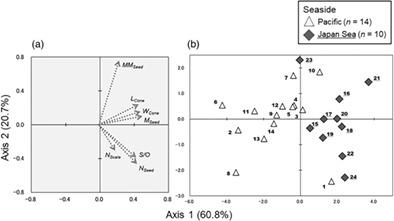当前位置:
X-MOL 学术
›
Plant Species Biol.
›
论文详情
Our official English website, www.x-mol.net, welcomes your
feedback! (Note: you will need to create a separate account there.)
Geographical cline and inter‐seaside difference in cone characteristics related to climatic conditions of old planted Pinus thunbergii populations throughout Japan
Plant Species Biology ( IF 1.1 ) Pub Date : 2020-12-19 , DOI: 10.1111/1442-1984.12309 Masakazu G. Iwaizumi 1 , Koji Matsunaga 2 , Taiichi Iki 3 , Taro Yamanobe 4 , Tomonori Hirao 5 , Atsushi Watanabe 6
Plant Species Biology ( IF 1.1 ) Pub Date : 2020-12-19 , DOI: 10.1111/1442-1984.12309 Masakazu G. Iwaizumi 1 , Koji Matsunaga 2 , Taiichi Iki 3 , Taro Yamanobe 4 , Tomonori Hirao 5 , Atsushi Watanabe 6
Affiliation

|
Although cone morphology has been mainly utilized for taxonomy or forestry purposes, characterization of the environmental factors that influence its variation is still insufficient. Major conifers distributed over diverse climatic conditions like the Japanese archipelago could show cone morphology variation among populations related to large differences in key influential factors such as temperature, snow, irradiance and sunshine. Geographical variation in cone characteristics (cone size, seed production, seed productivity per cone and seed size) was examined across the species distribution in 24 old planted Pinus thunbergii populations (479 trees) along two major seasides in Japan (Pacific Ocean side and Japan Sea side). Variance components of cone characteristics explained by seaside were at similar levels to those for populations nested within seasides. Populations on the Japan Sea side produced cones that had larger size (length and width), higher seed production (number of filled seeds per cone and seed mass per cone) and seed productivity per cone (seed‐to‐ovule ratio). Analysis of covariance showed that significant latitudinal clines observed in cone size and seed productivity per cone were mostly a result of inter‐seaside differences. Linear mixed model analysis detected that geographical variation in cone size, seed production and seed productivity per cone in the populations were affected significantly by low temperature, more snow, less solar irradiance and less sunshine time. Large cone sizes and high seed productivity per cone found in the populations on the Japan Sea side could be explained by a genetic or plastic response to maintain reproductive success.
中文翻译:

与日本全国老龄黑松种群的气候条件有关的圆锥特征的地理界线和滨海地区差异
尽管视锥形态主要用于分类学或林业目的,但影响其变化的环境因素的表征仍然不足。分布在不同气候条件下的主要针叶树(如日本群岛)可能显示出种群间的锥状形态变化,这与关键影响因素(如温度,雪,辐照度和日照)的巨大差异有关。研究了24种老植松的物种分布中视锥特性的地理变化(视锥大小,种子产量,每个视锥的种子生产力和种子大小)。日本两个主要海边(太平洋和日本海边)的种群(479棵树)。海边解释的锥状特征的方差分量与嵌套在海边的种群的方差分量相似。日本海一侧的种群所产的视锥具有更大的尺寸(长度和宽度),较高的种子产量(每个视锥中的已填充种子数和每个视锥的种子质量)和每个视锥的种子生产力(种子/胚珠比)。协方差分析表明,在视锥大小和每个视锥种子产量上观察到的显着的纬度倾斜主要是海边差异的结果。线性混合模型分析发现,低温,多雪,更少的太阳辐射和更少的日照时间。在日本海一侧种群中发现的大球果大小和每个球果高的种子生产率可以用遗传或塑性反应来维持繁殖成功来解释。
更新日期:2020-12-19
中文翻译:

与日本全国老龄黑松种群的气候条件有关的圆锥特征的地理界线和滨海地区差异
尽管视锥形态主要用于分类学或林业目的,但影响其变化的环境因素的表征仍然不足。分布在不同气候条件下的主要针叶树(如日本群岛)可能显示出种群间的锥状形态变化,这与关键影响因素(如温度,雪,辐照度和日照)的巨大差异有关。研究了24种老植松的物种分布中视锥特性的地理变化(视锥大小,种子产量,每个视锥的种子生产力和种子大小)。日本两个主要海边(太平洋和日本海边)的种群(479棵树)。海边解释的锥状特征的方差分量与嵌套在海边的种群的方差分量相似。日本海一侧的种群所产的视锥具有更大的尺寸(长度和宽度),较高的种子产量(每个视锥中的已填充种子数和每个视锥的种子质量)和每个视锥的种子生产力(种子/胚珠比)。协方差分析表明,在视锥大小和每个视锥种子产量上观察到的显着的纬度倾斜主要是海边差异的结果。线性混合模型分析发现,低温,多雪,更少的太阳辐射和更少的日照时间。在日本海一侧种群中发现的大球果大小和每个球果高的种子生产率可以用遗传或塑性反应来维持繁殖成功来解释。









































 京公网安备 11010802027423号
京公网安备 11010802027423号